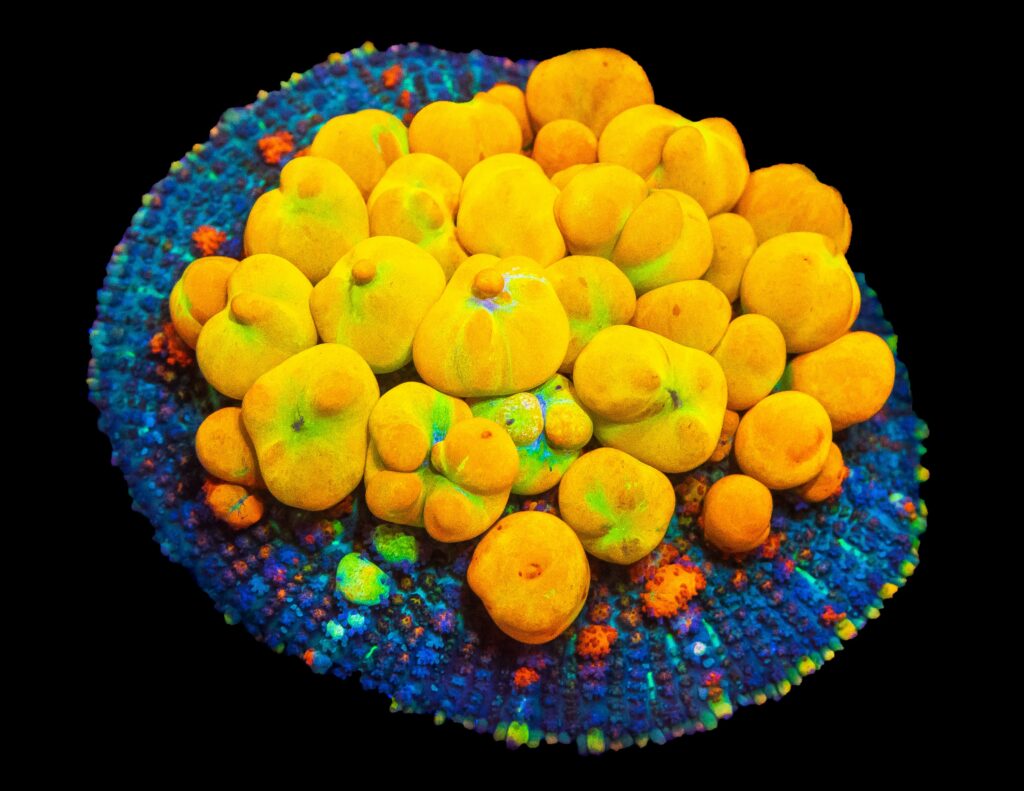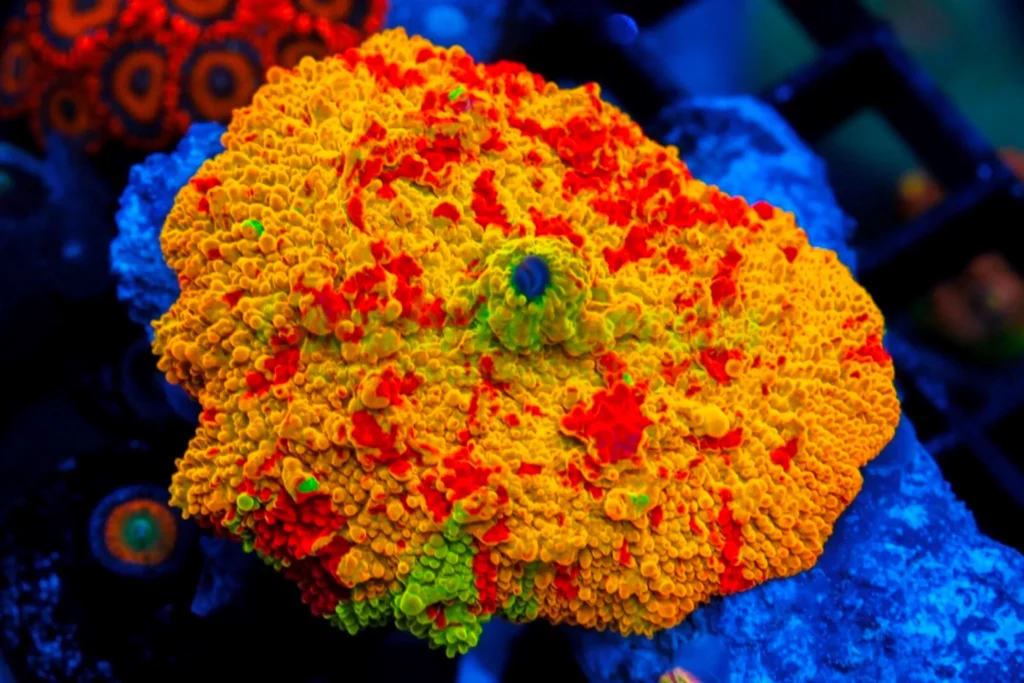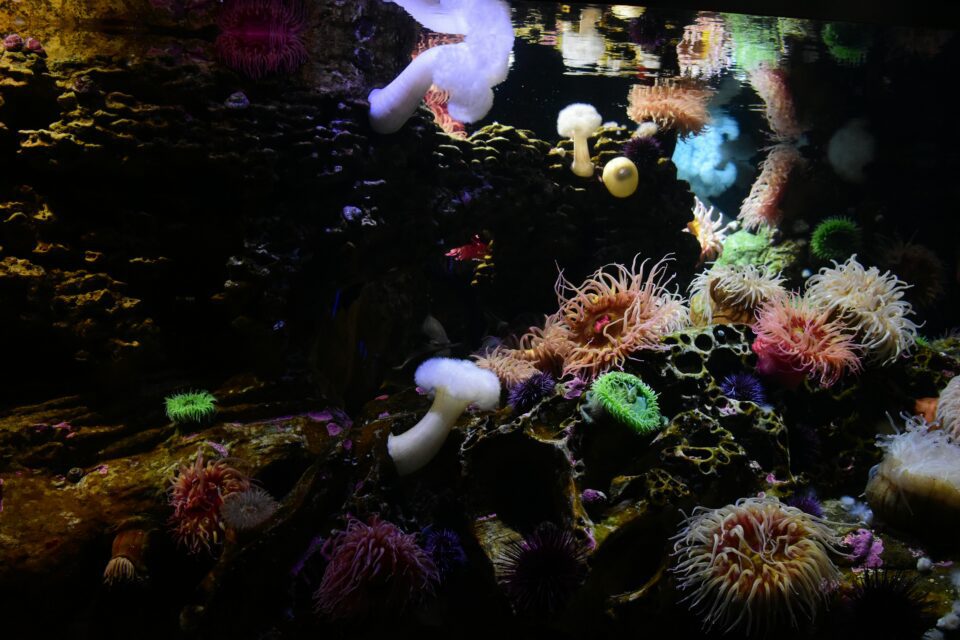
Mushroom corals are a staple in the saltwater aquarium hobby, known for their resiliency and vibrant colors. These corals, belonging to the family Discosomatidae, are not only a visually striking addition to marine tanks but also among the easiest types of corals to maintain, making them perfect for both novice and experienced aquarists. This comprehensive guide will delve deep into everything you need to know about keeping mushroom corals in your home aquarium, ensuring your underwater garden thrives.
What Are Mushroom Corals?
Mushroom corals refer to a variety of coral species that share a similar shape—broad, flat, and often resembling the cap of a mushroom. These corals are a type of soft coral, devoid of the rigid, stony skeleton that characterizes their hard coral counterparts. Mushroom corals are particularly noted for their ability to adapt to a range of lighting conditions and their propensity for propagation, which involves splitting their bodies to form new individuals—a process that fascinates many aquarists.
Understanding Mushroom Corals in Aquatic Ecosystems
In their natural habitats, primarily found in the shallow waters of the Indo-Pacific, mushroom corals can be seen carpeting the seabed, where they receive ample sunlight. They play a crucial role in the reef ecosystem, providing shelter and habitat for various marine organisms. The understanding of their natural environment is vital for replicating similar conditions in home aquariums, which is essential for their health and growth. To read more about their ecological role, visit MarineBio, which offers extensive insights into their interactions within marine ecosystems.
Types of Mushroom Corals Suitable for Home Aquariums
Among the various types of mushroom corals, some of the most popular include:
- Ricordea – Known for their intense colors and bubbly appearance, Ricordea corals are a favorite among aquarists. They come in two types: Ricordea florida and Ricordea yuma, with Ricordea florida being more common in the Caribbean.
- Discosoma – These are the quintessential mushroom corals, recognized for their flat, disc-like appearance. They are available in a myriad of colors and patterns.
- Rhodactis – Similar to Discosoma but generally thicker and often more textured, Rhodactis mushrooms can add a significant visual impact to any tank.
For those interested in exploring different species of mushroom corals for sale, a visit to Artistic Oceans provides a detailed catalog of available options.

Setting Up Your Aquarium for Mushroom Corals
Creating the perfect environment for mushroom corals in your home aquarium involves understanding and implementing the right conditions that mimic their natural habitat. This section will guide you through the essential setup requirements, from choosing the right tank to controlling the water parameters effectively.
Essential Equipment for Mushroom Coral Tanks
To begin, let’s discuss the equipment you will need to create an ideal home for your mushroom corals:
- Aquarium Tank: Mushroom corals do well in tanks of all sizes but starting with at least a 20-gallon tank is advisable as it provides adequate space for water stability and coral spread.
- Lighting: While mushroom corals are less demanding about lighting compared to other corals, providing moderate lighting will help maintain their vibrant colors. LED lights that can be dimmed are ideal for adjusting the intensity as needed.
- Water Flow: Mushroom corals thrive in moderate water flow. This helps them receive the nutrients they need and keeps their surface clean from debris. Powerheads or wave makers can be used to achieve the desired water movement.
- Substrate: These corals are not particular about the type of substrate, but a fine sandy bottom mimics their natural habitat and can help in their propagation.
Each piece of equipment plays a crucial role in the health and growth of mushroom corals. Proper installation and maintenance of these elements ensure your corals not only survive but thrive. For more details on aquarium equipment and setup, Artistic Oceans offers a wealth of information and products tailored to your aquarium needs.
Water Parameters and Conditions
Maintaining the right water chemistry is vital for keeping mushroom corals healthy:
- Temperature: Keep the water temperature between 72 to 78°F (22 to 26°C).
- pH: The pH level should be maintained between 8.1 and 8.4.
- Salinity: Aim for a salinity level of 1.023 to 1.025 specific gravity.
- Alkalinity: Keep alkalinity between 8 and 12 dKH to help corals build their tissue.
It’s important to use a reliable water testing kit to monitor these parameters regularly. Sudden changes in water chemistry can stress your corals, leading to disease or death.
The Best Placement for Mushroom Corals in Your Aquarium
When placing mushroom corals in your aquarium, consider the following:
- Low to Mid-Level Placement: Depending on the lighting, mushroom corals usually do well in low to mid-level tank placements.
- Avoid High Flow Areas: While they need some water movement, too strong a flow can cause them to become detached.
- Grouping: Group different types of mushroom corals together to create a more natural and appealing display. Ensure they have enough space to expand and grow.
Setting up your aquarium correctly is a crucial step towards a successful mushroom coral reef tank. For a step-by-step guide on setting up specific tank configurations and additional tips on aquatic settings, visit Artistic Oceans.

Caring for Mushroom Corals
Proper care is essential to ensure your mushroom corals not only survive but thrive in your home aquarium. This section provides detailed information on feeding, common health issues, and propagation techniques.
Feeding Mushroom Corals
Mushroom corals are mostly photosynthetic, relying on the symbiotic algae, zooxanthellae, living in their tissues for nutrients produced via photosynthesis. However, they benefit from supplemental feeding, which can enhance their growth and coloration:
- Feeding Schedule: Feed your mushroom corals small amounts of food once or twice a week. Overfeeding can lead to poor water quality and increase the risk of diseases.
- Types of Food: Suitable foods include finely minced seafood, such as shrimp, squid, and clam, as well as commercial coral foods. Reef Roids, available from vendors like Artistic Oceans, is a popular choice among coral enthusiasts in Las Vegas.
Common Health Issues and Solutions
Even with the best care, mushroom corals can sometimes encounter health problems. Recognizing and addressing these issues promptly can make a significant difference in their recovery:
- Bleaching: Often caused by too much light or stress, bleaching occurs when corals expel their zooxanthellae. Adjusting light levels and ensuring optimal water conditions can help them recover.
- Tissue Necrosis: This can result from poor water quality or physical damage. Improve water conditions and consider using coral dips to remove pathogens.
Regular monitoring and maintenance of water quality are crucial in preventing most health issues. For more detailed health management tips, Artistic Oceans provides resources on coral health and disease prevention.
Propagating Mushroom Corals
Mushroom corals are one of the easiest corals to propagate, making them excellent candidates for aquarists interested in expanding their coral collections:
- Fragging Method: Carefully cut a piece of the mushroom coral’s cap with a sterile blade and attach it to a new substrate using reef-safe glue or a similar attachment method.
- Conditions for Success: Ensure the fragging area is clean, and water parameters are stable to promote healing and growth.
Propagation not only helps in expanding your coral collection but also assists in maintaining the health of the parent coral by reducing overcrowding.

Advanced Care Techniques
To elevate the care of your mushroom corals and ensure they display their most vibrant colors and robust health, consider these advanced care techniques:
Enhancing the Coloration of Mushroom Corals
The coloration of mushroom corals can be significantly enhanced through careful attention to lighting and nutrition:
- Lighting: Utilize adjustable LED lighting to find the perfect balance that enhances their natural colors without causing stress or bleaching.
- Supplemental Feeding: Regular feeding with nutrient-rich foods can help deepen and brighten the colors of mushroom corals.
Handling Mushroom Coral Aggression
Mushroom corals can sometimes exhibit aggressive behavior towards other corals by extending their mesenterial filaments to digest competitors:
- Spatial Planning: Provide ample space between mushroom corals and other types of corals to prevent chemical warfare.
- Regular Monitoring: Watch for signs of stress in neighboring corals, which might indicate aggression from mushroom corals.

Common Mistakes to Avoid with Mushroom Corals
To help you avoid common pitfalls in mushroom coral care, here are a few tips:
- Overlighting: Too much light can lead to bleaching. It’s crucial to find the right balance based on the specific needs of your mushroom corals.
- Neglecting Water Quality: Consistent water quality checks and maintenance are vital. Poor conditions can quickly lead to health issues.
Conclusion
Mushroom corals are a beautiful and rewarding addition to any home aquarium. With the right setup, regular care, and attention to their specific needs, they can thrive and bring vibrant life to your aquatic world. For ongoing tips and guidance, connect with fellow enthusiasts and experts at Artistic Oceans.
Feel free to explore more about mushroom corals and share your experiences in the comments below, or ask questions to deepen your understanding and expertise in coral care.




